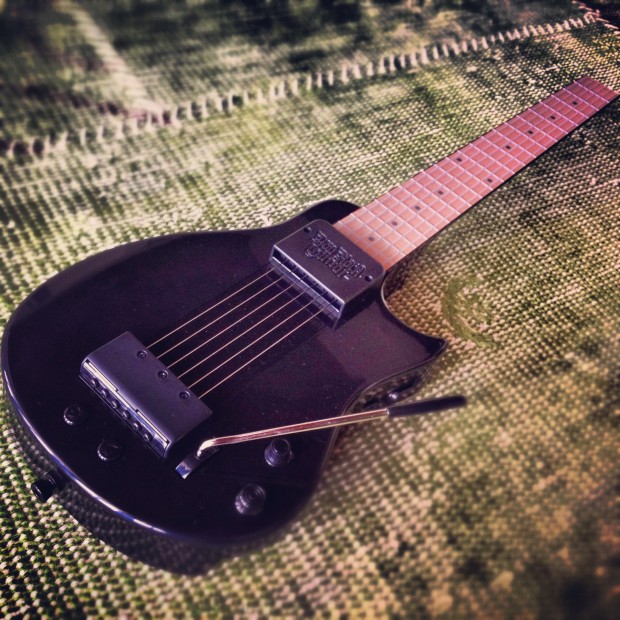You Rock Review
Can a toy guitar, the delightfully named You Rock, also become a studio workhorse?
The newest guitar in my studio is certainly something of an oddity. The wonderfully named You Rock Guitar is, first and foremost, a game controller. There’s no question that straight out of the box it looks and feels like a toy.
But, thanks to some clever developments, it can function as a MIDI controller, which means I can plug it into my Mac and drive synthesisers and sample players with it for a fraction of the price of serious guitar-style MIDI controllers. At least, that’s what the marketing suggests.
Before Getting Started
I ordered my You Rock Guitar from AudioMidi in the US and it arrived safely and well packed. The You Rock Guitar is ready to play straight out of the box.
Unfortunately, the printed manual that comes with the it is not great. It lacks detail about a number of important features, including the TAP and SLIDE modes, which I will mention later.
Thankfully, a quick visit to the You Rock Guitar website gave me loads more information on how to set up the controller and a heads up about a free software download, that gave me a firmware update (highly recommended) and a computer software controller programme (essential for serious studio work).
Look, Feel And Design
The You Rock Guitar is plastic, but solid, in a built to last kind of way. The detachable neck clicks easily into place and you can connect it up with either with a standard MIDI cable or USB.
The neck has no strings. In their place, you have six elastic-like strips of contacts, running across plastic frets. On the body, there are six strings, not connected to the neck. There’s a whammy bar (which does not effect the string pressure) as well as various switches and other controls.
Stuff I Don’t Use
It’s worth remembering that this controller is primarily designed for games and interestingly, for kids who might want to make the transition from music games to actually playing music themselves. So, it ships with an onboard synth that can be plugged into any sort of amplifier, some backing tracks to jam along with and even a chord and scale learning mode.
I’ve not tested these features out. But, it’s cool, to see them being developed.
You Rock MIDI
My interest in the You Rock Guitar came solely from the promise of being able to control Logic Pro, Kontakt and Reason with a simple (and cheap) guitar style controller. Although I can play keyboards well enough to input basic chords and lines in real time, I’m nowhere near as expressive on a keyboard as I am on the cheapest of guitars.
The first few attempts with the You Rock Guitar were not promising. I had trouble getting it to hold notes cleanly and was either getting false triggers or no trigger at all when using the string controllers.
However, things improved noticeably once I a) installed the firmware upgrade, b)adjusted the string tension (via screws on the bridge) and c) switched to using a pick.
Getting Into The Modes
The You Rock Guitar has three modes that add to its versatility. All of them accessed from a switch bank on the top of the guitar’s body.
Normally the You Rock Guitar dampens open string sounds. But the OPEN mode, lets them ring out, which is good if you want to let open string arpeggios ring, or for getting the most from exotic samples like Gu Zheng or Sitar.
The SLIDE mode, as the name suggests, slides from one note to another. You need to keep the initial note pressed while you activate the new note, but it’s fairly intuitive once you get into it.
Finally, the TAP mode lets you activate notes just by fretting them, without needing to pick the string. I found that for some, very sensitive sample sets, this mode was more controllable. Also, in this mode I use my right hand to switch in and out of the SLIDE mode, while playing string, brass or synth patches.
The Controller Software
As I mentioned, you can download a controller programme from the You Rock Guitar website. This allows you do to some important adjustments to the controller’s performance.
For example, you adjust the picking sensitivity and the travel of the whammy bar (I have mine set to ± 2 semi-tones). Also, you can also implement non-standard tunings or capo-style transposition.
Conclusions
The You Rock Guitar is a fun toy for serious studios. Even if you can play a MIDI keyboard, the You Rock Guitar is a cool and expressive alternative for playing and programme soft synths and sample players. And, of course, if you are a guitarist who struggles at the keyboard, the You Rock Guitar might well open up a world of possibilities.
There are still some glitches and occasional missed notes however, even with the firmware upgrade. And, with some sample libraries, you don’t always feel completely in control of the velocity and volume.
To be honest, I probably wouldn’t use this on a gig for anything other than novelty value. Although, I have to admit, it would be fascinating to try and play with just a You Rock Guitar and an iPad!
Ultimately, I bought the You Rock Guitar to play in the studio and I’m having a blast doing so. In fact, the only problem I have now is finding a small space close to my desk for it to live. Because, I want to keep this controller close by and use it often!





